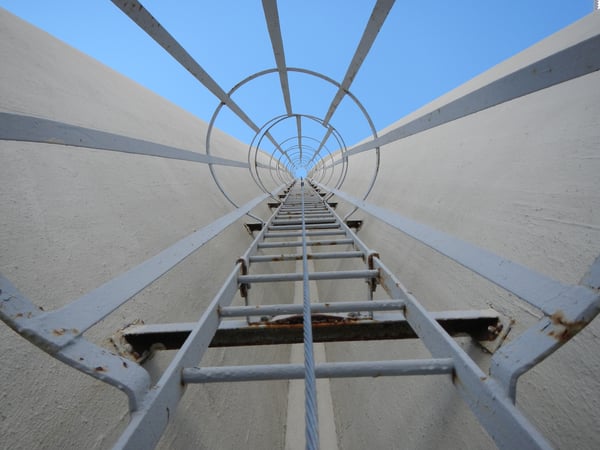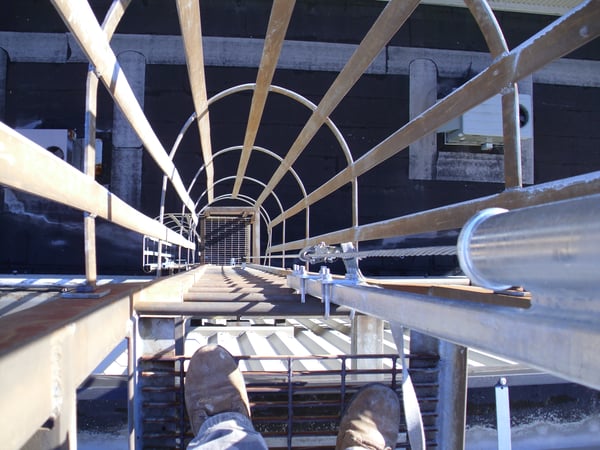Fixed ladder systems are common features on cell phone towers, oil platforms, storage silos, water towers, and wind turbines just to name a few. Each of these applications requires climbing a fixed ladder to perform maintenance, inspection, and repair activities, but workers climbing permanently fixed ladder systems often have a a false sense of security. This post discusses fall protection options for ladder climbing applications and explores the pros and cons of common vertical fall arrest solutions.
In a previous post on fall protection options for vertical climbing applications, we noted that OSHA regulations call for use of a vertical lifeline or a ladder equipped with a cage system on fixed ladders over 24 feet. As a best practice, we recommend the use of vertical lifelines over ladder cages because a cage does nothing to stop a vertical fall. With a cage system, a worker that slips on a ladder rung can drop from the top of the structure to the ground below, or hit the cage on the way down and lose consciousness inside the cage, making rescue extremely difficult. The picture blow puts the danger in context:
If you look carefully at the picture above, you’ll notice that the fixed ladder is also equipped with a vertical lifeline. By connecting to the vertical lifeline using a “rope grab” deceleration device, the worker can climb freely up and down the ladder as long as tension is slack on the lifeline. During a fall, the rope grab automatically engages the vertical lifeline’s steel cable and locks, arresting the worker’s uncontrolled descent in under a foot.
The video below features Capital Safety’s Lad-SafX2 Cable Sleeve, which we recommend for use with the Vertical Lifeline Systems we install. Although a portion of the video is designed to focus on this item, you get a better idea how vertical lifeline systems work and why they are an obvious choice over ladder cage systems.
The picture below shows a top-down view of a vertical lifeline system. The cylindrical structure at the very top of the system is an energy absorber designed to protect the user and the structure in the event of a fall.
To the untrained eye, lifelines for permanent ladder systems seem remarkably simple in function and their installation is a relatively straightforward process. Some of our clients opt to perform their own installations, but if you are considering this route, remember:
- The climbing structure must be capable of supporting the loads imposed by the system in the event of a fall
- Some installations require welding brackets to the structure–work that should be completed by a certified professional welder
- Care must be taken to avoid crushing or collapsing rungs while tightening the cable clamps
- The use of non-approved components and subsystems can affect the safety and reliability of the system
- Your personnel may not be comfortable working at heights during the installation process–if this the case, arrange for professional installation
Even with professional installation, the install and maintenance costs associated with vertical lifelines are significantly lower than ladder cage systems–and the systems are actually designed to arrest falls rather than simply making workers feel safe while scaling a ladder. To learn more about vertical lifelines and their installation, or to request a lifeline quote, contact Diversified Fall Protection for further assistance.
***********
Diversified Fall Protection designs, manufactures, and installs OSHA Compliant fall protection systems, including horizontal lifelines, rigid trolley beam fall arrest systems, vertical lifelines, and rooftop guardrail. To learn more about our turnkey approach to fall protection, please contact us for expert assistance with your safety needs.



